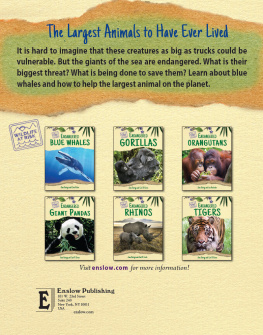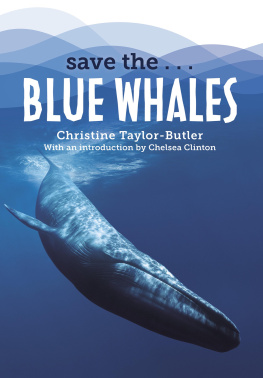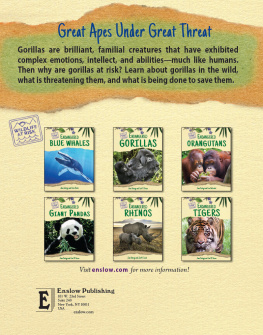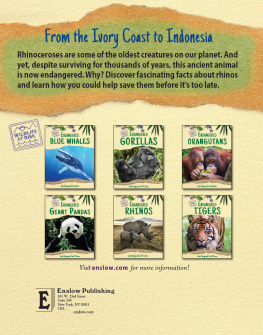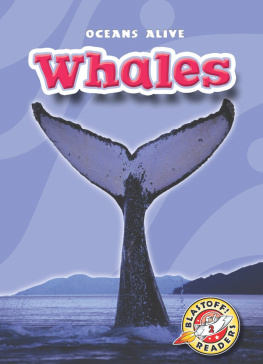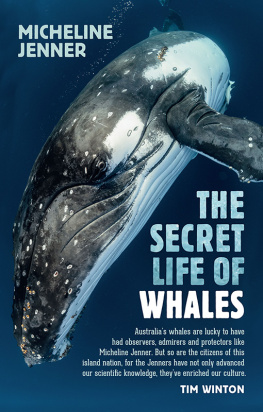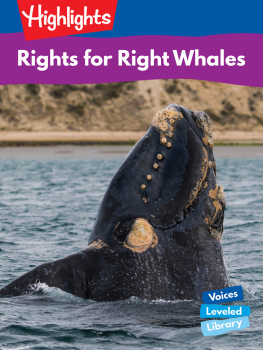Published in 2016 by Enslow Publishing, LLC.
101 W. 23rd Street, Suite 240, New York, NY 10011
Copyright 2016 by Enslow Publishing, LLC.
All rights reserved.
No part of this book may be reproduced by any means without the written permission of the publisher.
Library of Congress Cataloging-in-Publication Data
Katirgis, Jane, author.
Endangered blue whales / Jane Katirgis and Chris Reiter.
pages cm. (Wildlife at risk)
Summary: Discusses blue whales, why they are endangered, and how they are being helped--Provided by publisher.
Audience: Ages 11+
Audience: Grades 7 to 8
Includes bibliographical references and index.
ISBN 978-0-7660-6890-2 (library binding)
ISBN 978-0-7660-6888-9 (pbk.)
ISBN 978-0-7660-6889-6 (6-pack)
1. Blue whaleJuvenile literature. 2. WhalesJuvenile literature. 3. Rare mammalsJuvenile literature. I. Reiter, Chris, author. II. Title.
QL737.C424K37 2016
599.5248dc23
2015009975
Printed in the United States of America
To Our Readers: We have done our best to make sure all Web site addresses in this book were active and appropriate when we went to press. However, the author and the publisher have no control over and assume no liability for the material available on those Web sites or on any Web sites they may link to. Any comments or suggestions can be sent by e-mail to .
Portions of this book originally appeared in the book The Blue Whale.
Photos Credits: Brian J. Skerry/National Geographic/Getty Images, p..
Cover Credits: SCIEPRO/Science Photo Library/Getty Images (blue whale); oakim Leroy/E+/Getty images (palm leaf); Creativ Studio Heinemann/Creative (RF)/Getty Images (borage flowers); Maria Toutoudaki/Photodisk/Getty Images (background paper texture).
BLUE WHALES AT A GLANCE
Class
Mammalia
Family
Balaenopteridae
Genus
Balaenoptera
Species
musculus
Average Length
70 to 100 feet (21 to 30 meters)
Females are about 5 percent longer than males.
Average Weight
100 to 120 tons (91 to 109 metric tons)
Life Span
More than 80 years
Status
Listed by the United States Fish and Wildlife Service (USFWS) as endangered on June 2, 1970.
Skin Color
Bluish gray and mottled with gray and white
Underside yellowish or whitish
Teeth
Baleen (whalebone) strips extending from 270 to 395 plates in the jaw.
Breeding Season
Midwinter months
Gestation Period
11 to 12 months
Offspring
One every 2 to 3 years
Range
Worldwide; separate northern and southern stocks
Maximum Speed
Faster than 19 mph (30 kph)
Threats to Survival
Hunting by humans, habitat loss, pollution, competition with humans for food
Voice
Low, rumbling, often arranged in patterns
Spout
Up to 30 feet (9 meters) high
chapter one
THE LARGEST ANIMAL
Heres a question for you: What animal weighs more than ten adult elephants and has a heart the size of a smart car? The answer is the largest animal that has ever lived on earth. This animal is also quite hungry. It eats the equivalent of about 32,000 hamburgers in just a day. That is a serious appetite.
A creature so big and with an appetite so enormous surely has to be the hulking, meat-eating Tyrannosaurus rex or the towering Apatosaurus. But in fact, the worlds largest animal ever is not an extinct dinosaur. It is alive today and swimming in all the worlds oceans. It is the giant of the sea, the blue whale.
Just how big is the blue whale? Lets go back to the heart. Its as large as a small car because it must move blood the entire length of the whales long, streamlined body, which is an astonishing 100 feet (30 meters). It would take twenty schoolchildren lying end to end in a straight line to equal the length of the blue whale. An average first-grader could actually crawl through the whales aorta, the large artery that carries blood from the whales heart to the rest of its body. Each beat of the blue whales heart pumps 60 gallons (227 liters) of blood into the aorta!
A Whales Diet
Such a huge animal needs a lot of food to keep it going. One might think that a blue whale would eat a few big fish every day to satisfy its hunger. But the whales diet is made up almost entirely of a tiny, shrimplike creature called krill. Trying to get full on krill is like trying to make three square meals out of a swarm of gnatsone would need to eat a lot of them. Thats just what the blue whale does. During its six-month feeding season in the cold polar seas, it devours 40 million krill every dayan amazing 8,000 pounds (3,629 kilograms) of krill! This is a very, very big animal.
A 22-foot (7-meter) boat looks like a small toy next to a blue whale. The blue whale is an endangered species despite its sizeand because of it. One blue whale provides much more blubber, whalebone, and oil than several smaller whales.
The blue whales size gives it many advantages. Large animals stay warm more easily than small ones and tend to expend less energy feeding. Blue whales also have few predators. Killer whales, also known as orcas, sometimes attack young blue whale calves, but mature blue whales are rarely threatened. Even fierce sharks stay away from the mighty blue whale.
Krill are tiny shrimplike creatures that serve as the main food source for the enormous blue whale. Conservationists are now concerned that global warning is causing ice melts in the seas where krill live and blue whales feed, which would further endanger the species.
Fast Fact!
The blue whale is longer than a basketball court.
Their great size also gives blue whales a powerful voice. They make deep rumbling sounds that travel for hundreds of miles across the ocean. The sound is something like that of a foghorn or a tuba played underwater. Scientists believe that the blue whales calls are a way of communicating with other whales. As blue whales search for krill, for instance, a resounding bellow may tell other whales where to find a good meal.
Whales as Prey
Unfortunately, great size has its disadvantages, too. For centuries, ocean hunters coveted the blue whale. When they spotted a big blue whale swimming the open seas, they saw an unmatched source of meat, oil, and whalebone. Before electricity, whale oil was burned in lanterns to provide light. Whale meat was an important part of the diet of many people. Whalebone was used in corsets and umbrellas. Whalers could make a profit from selling those products. But the early whalers were no match for the powerful, swift-swimming blue whale. Their open rowboats were too slow, and their hand-held harpoons were too weak. Late in the nineteenth century, however, whalers began to use fast steam-powered boats, harpoon cannons, and exploding harpoons. By 1900, whalers were killing thousands of blue whales each year. In 1931, more than 29,000 blue whales were killed in a single season.
Whaling
Modern commercial whaling nearly wiped out the worlds population of blue whales. Scientists estimate that a population of 250,000 that lived before whaling began was reduced to fewer than 10,000. Some believe the numbers dropped as low as 2,000.

